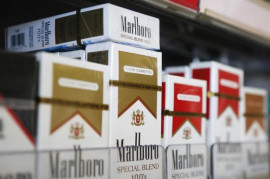
HYDERABAD: Emphasising on the kernel that human nutrition is interlinked with livestock animals' nutrition, the experts at a workshop proposed the use of a particular food supplement to address malnourishment. Mineral-Molasses Blocks (MMBs), which consist of molasses, wheat bran, mineral mixture, salt, urea and cement offering proteins, vitamins and minerals, increase growth and productivity of the livestock, the experts said.
The two-day workshop, organised by European Union funded Programme for Improved Nutrition in Sindh (PINS) and Sindh Rural Partners Organisation (SRPO), began at Sindh Agriculture University on Wednesday. "There is a very strong link between livestock and human nutrition," underlined John Ashley, the nutrition expert working for PINS which started in January, 2018.
Citing his over a year-long exposure to the livestock farming in the province, Ashley said an overwhelming majority of these animals are undernourished. "Their diet is deficient of key elements". The fodder consumed by the animals is usually rich in carbohydrates and fibre but is devoid of micronutrients and protein.
Sindh CM presents Rs1,217b budget for next fiscal year
According to him, the deficiency affects growth of the livestock and reduces nutrition value of their milk and meat. "The MMBs can address one important aspect of that malnutrition [in the animals]," he asserted.
He said the consumption of MMBs is widespread internationally, adding that he has yet to identify the reasons why the mineral-molasses blocks supplement is not being used in Pakistan. He asked the academics and livestock breeders at the workshop to cudgel their brains to find out the causes.
Dr Aijaz Kumbhar, who is training the farmers about preparation of MMBs, said that the food supplement has also been tested to have improved reproduction of animals. According to him, a standard mineral-molasses block, which is shaped like a cake, weighs around 2.5 kilogrammes and the smaller one around 1 kg. "The animals lick the block after eating fodder. A cow or buffalo usually consumes up to 100g per day."
He said that farmers can themselves prepare the blocks at the cost of around Rs50 per kg while it is sold in the market at double the rate. "The animals are often seen licking bricks and sand to meet their mineral-demand. This is why the food supplement in the form of MMBs is important to fulfil their dietary needs".
The SRPO's Zahida Detho said that the livestock sector contributes 11.3% to the gross domestic product (GDP). She pointed out that though Pakistan is the third largest milk producing country, the production is not sufficient enough to meet the local demand. "How can the milk production increase if the animal nutrition remains low?"
Prof Ismail Kumbhar said that the application of harmful vaccines like oxytocin is widespread for enhancing milk production. He suggested that the farmers switch to the cheaper and harmless practice of feeding their animals the MMBs instead.
The chief conservator of forests, Aijaz Nizamani, lamented that though the livestock amounted to over 11% of the GDP, the bank financing for the sector is even less than 1% of the total financing. "The issue remains how to connect the policy with ground realities," he underscored.
Forest and Wildlife Secretary Abdul Raheem Soomro found the MMBs a wonderful food supplement and asked the academics and other stakeholders to spread information about the supplement, its benefits and preparation method among the farmers. Sindh Agriculture University (SAU) Vice-Chancellor Dr Mujeeb Sehrai also spoke.
Census of livestock
During the two-day workshop, technical sessions were held in which the experts shared their researches on different aspects of livestock feed and nutrition and their connection with the human nutrition.
The recommendation passed at the concluding session on Thursday underscored the need of the government's initiative for forming a comprehensive strategy to address malnutrition among people and livestock.
The experts called for conducting census of livestock at the district level, launching a lady health workers type programme to address the health needs of livestock and providing training about breeding, especially to rural women.
Budget allocation
In his budget speech in the Sindh Assembly on Friday, Chief Minister Syed Murad Ali Shah highlighted the importance of the livestock sector, saying that it promoted socio-economic development in the rural areas.
"It is highly labour intensive and involves a large segment of rural workforce. It is a source of cash income, providing a vital and often the only source of income for the rural households, playing an important role in poverty alleviation".
He also noted that the sector fetched foreign exchange earnings as well.
Under the Annual Development Project (ADP) 2018-19, 46 schemes including two new initiatives were taken up. The government had earmarked Rs652.5 million for development projects but less than half of the allocated Rs310.8 million were utilised. The allocation for livestock and fisheries department in ADP 2019-20 is Rs2 billion.

















































COMMENTS
Comments are moderated and generally will be posted if they are on-topic and not abusive.
For more information, please see our Comments FAQ